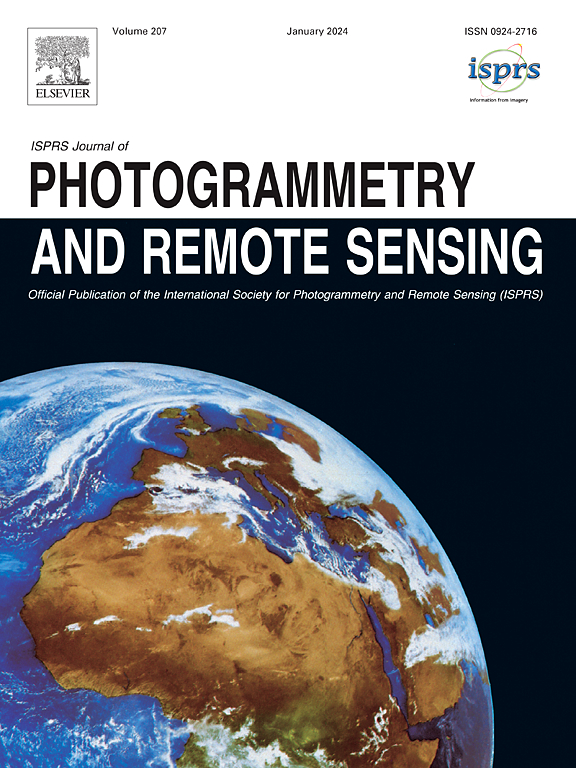Hybrid depth-event pose estimation for online dense reconstruction in challenging conditions
IF 10.6
1区 地球科学
Q1 GEOGRAPHY, PHYSICAL
ISPRS Journal of Photogrammetry and Remote Sensing
Pub Date : 2025-03-25
DOI:10.1016/j.isprsjprs.2025.03.013
引用次数: 0
Abstract
In this paper, we present a novel dense SLAM system based on depth-event fusion, aiming to address the challenge of online dense reconstruction in challenging environments. To achieve robust camera tracking, we devise a hybrid depth-event pose estimation framework based on random optimization, which estimates all states jointly. Notably, we introduce an innovative 3D-2D edge alignment method based on particle swarm optimization, specifically tailored for event cameras, to tackle the highly non-linear pose estimation problem. Furthermore, we implement a dynamic update mechanism for both geometric and intensity edges of the 3D reconstruction, enabling efficient and accurate management of edge information. Our method represents the first depth-event dense SLAM system employing a random optimization paradigm, achieving robust performance even with high-speed camera motion, specifically linear velocities exceeding 1 m/s and/or angular velocities exceeding 2 rad/s. The system achieves accurate and globally consistent dense mapping with a maximum spatial resolution of 2 mm, while maintaining real-time performance at approximately 30 FPS for simultaneous localization and 3D reconstruction. Through extensive evaluations on synthetic and real-world datasets, particularly on our newly constructed DEveSet dataset, we demonstrate the superior performance of our proposed method compared to state-of-the-art techniques such as InfiniTAM, ROSEFusion, and DEVO. Contact us for access to the DEveSet download link.
复杂条件下在线密集重建的深度-事件混合位姿估计
本文提出了一种基于深度-事件融合的密集SLAM系统,以解决复杂环境下的在线密集重建问题。为了实现鲁棒摄像机跟踪,我们设计了一种基于随机优化的深度-事件混合姿态估计框架,该框架联合估计所有状态。值得注意的是,我们引入了一种创新的基于粒子群优化的3D-2D边缘对齐方法,专门为事件相机量身定制,以解决高度非线性的姿态估计问题。此外,我们实现了三维重建的几何边缘和强度边缘的动态更新机制,实现了边缘信息的有效和准确管理。我们的方法代表了第一个采用随机优化范式的深度事件密集SLAM系统,即使在高速摄像机运动下,特别是线速度超过1米/秒和/或角速度超过2拉德/秒时,也能实现稳健的性能。该系统可实现精确且全局一致的密集映射,最大空间分辨率为2mm,同时保持约30 FPS的实时性能,用于同时定位和3D重建。通过对合成数据集和实际数据集的广泛评估,特别是对我们新构建的DEveSet数据集的评估,我们证明了与InfiniTAM、ROSEFusion和DEVO等最先进的技术相比,我们提出的方法具有优越的性能。联系我们获取DEveSet下载链接。
本文章由计算机程序翻译,如有差异,请以英文原文为准。
求助全文
约1分钟内获得全文
求助全文
来源期刊

ISPRS Journal of Photogrammetry and Remote Sensing
工程技术-成像科学与照相技术
CiteScore
21.00
自引率
6.30%
发文量
273
审稿时长
40 days
期刊介绍:
The ISPRS Journal of Photogrammetry and Remote Sensing (P&RS) serves as the official journal of the International Society for Photogrammetry and Remote Sensing (ISPRS). It acts as a platform for scientists and professionals worldwide who are involved in various disciplines that utilize photogrammetry, remote sensing, spatial information systems, computer vision, and related fields. The journal aims to facilitate communication and dissemination of advancements in these disciplines, while also acting as a comprehensive source of reference and archive.
P&RS endeavors to publish high-quality, peer-reviewed research papers that are preferably original and have not been published before. These papers can cover scientific/research, technological development, or application/practical aspects. Additionally, the journal welcomes papers that are based on presentations from ISPRS meetings, as long as they are considered significant contributions to the aforementioned fields.
In particular, P&RS encourages the submission of papers that are of broad scientific interest, showcase innovative applications (especially in emerging fields), have an interdisciplinary focus, discuss topics that have received limited attention in P&RS or related journals, or explore new directions in scientific or professional realms. It is preferred that theoretical papers include practical applications, while papers focusing on systems and applications should include a theoretical background.
 求助内容:
求助内容: 应助结果提醒方式:
应助结果提醒方式:


